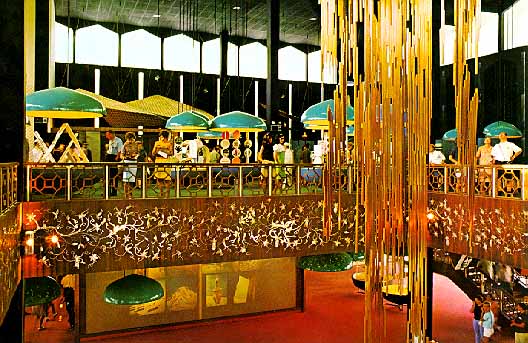Iran Pavilion
The Pavilion of Iran was on the Ile Sainte-Helene across from the Metro station. Its architectural style was inspired by an ancient Iranian structure, and its decorative tile work was an authentic example of Iranian decorative art.Its theme, "A Thousand and One Faces of Iran", recalled the splendors of the Persian Empire, and described the advances made under the regime of the Shah of Iran in two floors of exhibits. On display in the section devoted to tradition were caskets of the Kajar period, Seljuk bronzes, spoons and pots left by the Mongols, 12th and 13th century bronzes and china vases inlaid with silver, golden vases 3000 years old, amphora and hand-painted ceramics.

| Iran's pavilion was adorned by decorative tile work. |
Films and pictures, projected on the walls of the central hall, covered many aspects of Iranian life from archaeological digs to the most recent economic development plan. A huge photographic montage, divided into several sections, gave visitors a progress report on many projects ranging from agrarian reform, the gradual emancipation of women, communal developments, electoral reform, and improvements in education and health services.
In the displays showing the work undertaken to improve the country's standard of living, the oil industry was the keystone. There were photographs and models of oil and gas pipelines, refineries, oil wells and chemical plants.
 |
Interior of the Iranian pavilion. |
Iranian craftsmen's work was displayed. Visitors could admire stained glass from Teheran, rich brocades, the inland and carved woodwork of Shiraz, birds of ornamental metal and engraved golden ornaments of Ispahan, silks from Tabiz, vases, silver enameled lanterns and embroidered sheepskin jackets. Beautiful Persian carpets formed a constant background in the pavilion, and in one section visitors could watch carpet-makers at their looms.

| Decorative interior wall of Iran's pavilion. Photo by Bill Dutfield. |
On the patio a bar served Iranian vodka, caviar and other specialties.

| Iran pavilion at night. Photo by Bill Dutfield. |